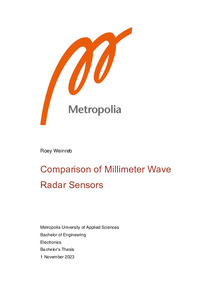Comparison of Millimeter Wave Radar Sensors
Weinreb, Roey (2024)
Weinreb, Roey
2024
All rights reserved. This publication is copyrighted. You may download, display and print it for Your own personal use. Commercial use is prohibited.
Julkaisun pysyvä osoite on
https://urn.fi/URN:NBN:fi:amk-202404035574
https://urn.fi/URN:NBN:fi:amk-202404035574
Tiivistelmä
Millimeter wave (mmWave) radar employs electromagnetic waves within the millimeter-wave band, ranging frequencies from 30 to 300 GHz. It offers numerous benefits compared to alternative radar types, such as enhanced resolution, deep penetration capabilities, and minimal interference. These advantages render mmWave radar highly suitable for diverse applications spanning automotive, security, and manufacturing sectors.
The purpose of this thesis is to compare 24 GHz and 60 GHz mmWave radar sensors. The thesis begins with a literature review of mmWave radar, including its history, applications, and the 24 GHz and 60 GHz bands. The thesis then describes the design of the 24 GHz and 60 GHz mmWave radar systems. The work concludes with a presentation of the experimental results for the two systems, including the range performance, resolution performance, and penetration performance. As a source material the data sheet of the two sensors was used.
As result it appears that each band has its own advantages and disadvantages. 24 GHz radar has better penetration and range than 60 GHz radar, but it has lower resolution. 60 GHz radar has higher resolution than 24 GHz radar, but it has shorter range and worse penetration.
The purpose of this thesis is to compare 24 GHz and 60 GHz mmWave radar sensors. The thesis begins with a literature review of mmWave radar, including its history, applications, and the 24 GHz and 60 GHz bands. The thesis then describes the design of the 24 GHz and 60 GHz mmWave radar systems. The work concludes with a presentation of the experimental results for the two systems, including the range performance, resolution performance, and penetration performance. As a source material the data sheet of the two sensors was used.
As result it appears that each band has its own advantages and disadvantages. 24 GHz radar has better penetration and range than 60 GHz radar, but it has lower resolution. 60 GHz radar has higher resolution than 24 GHz radar, but it has shorter range and worse penetration.
